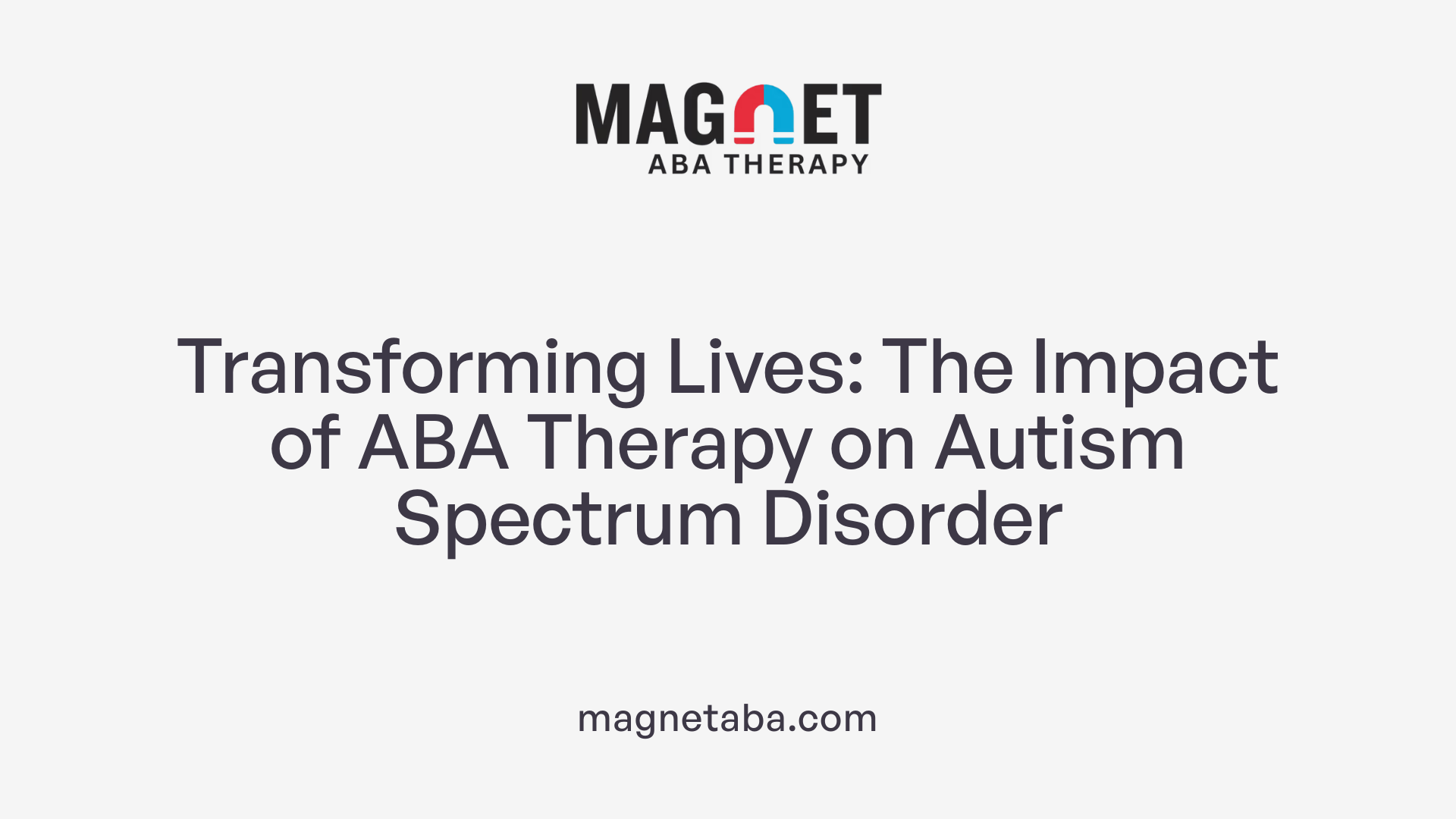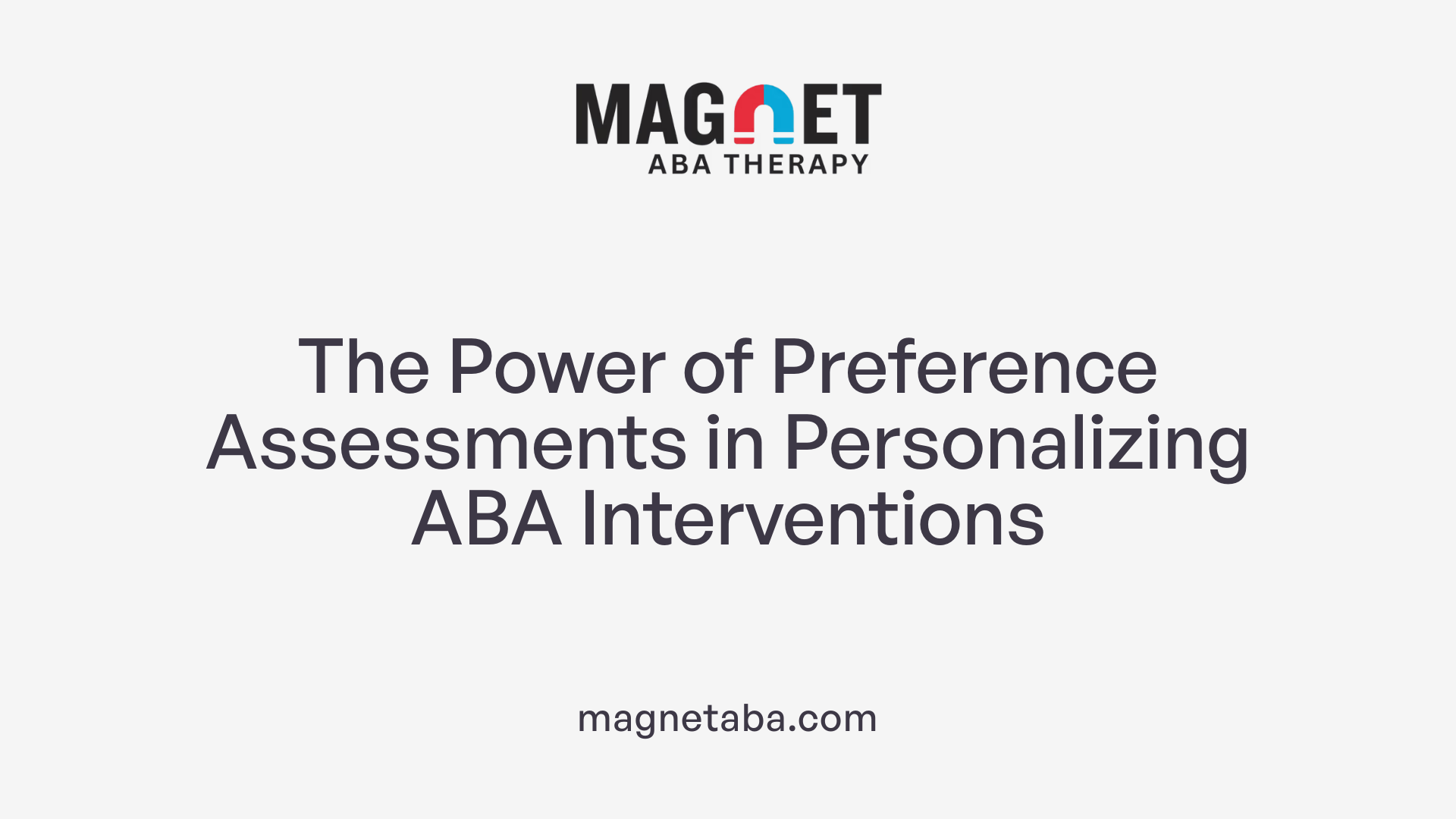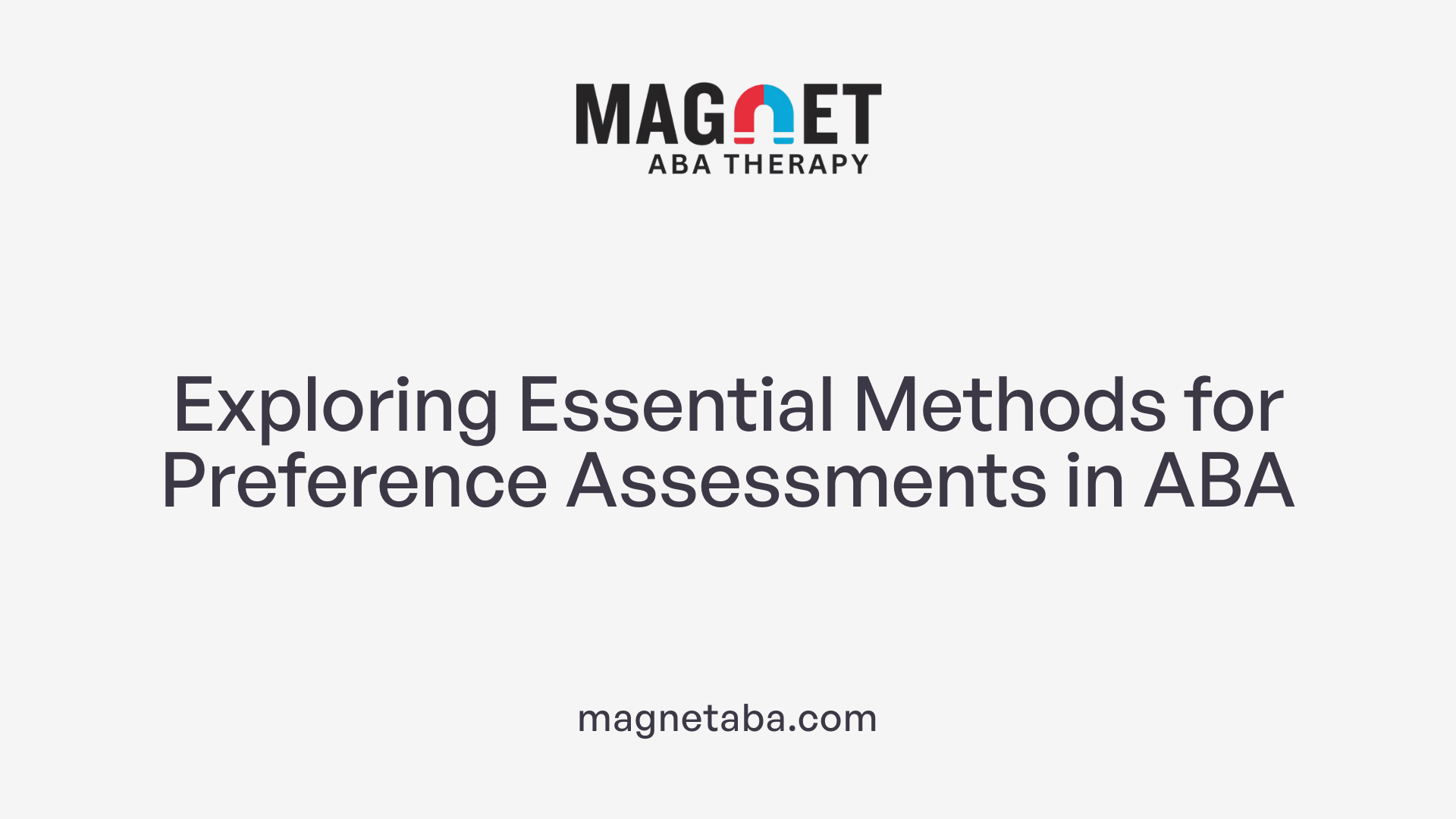Understanding the Role of Preference Assessments in ABA Therapy
Applied Behavior Analysis (ABA) therapy is renowned for its rigor and efficacy in treating Autism Spectrum Disorder (ASD), focusing on individualized interventions that promote essential skills while reducing challenging behaviors. A critical, though sometimes underemphasized component of ABA is the use of preference assessments — systematic methods to identify what motivates and engages each child. This article explores how preference assessments play an indispensable role in tailoring ABA therapy to maximize developmental gains and quality of life, supported by evidence-based applications and best practices.
Defining Applied Behavior Analysis (ABA) Therapy and Its Foundations
What is Applied Behavior Analysis (ABA) therapy?
Applied Behavior Analysis (ABA) therapy is a scientifically-based treatment focused on understanding and modifying behavior through principles of learning, particularly operant conditioning. It assesses individual needs to create personalized programs targeting skill development across communication, social interaction, self-care, and academics.
Principles of behavior analysis
ABA stems from behaviorism, examining how environmental factors shape behaviors. This approach uses a systematic analysis of antecedents (what happens before behavior), behaviors themselves, and consequences, often called the A-B-C model, to understand and influence behavioral patterns.
Operant conditioning in ABA
At the core of ABA is operant conditioning, which reinforces desired behaviors by applying positive consequences and reduces unwanted behaviors by modifying reinforcement. This technique helps encourage skills building while limiting behaviors like aggression or self-injury.
Individualized program development
Each ABA therapy program is tailored to the individual's developmental profile and family priorities. Initial comprehensive assessments guide setting specific, measurable, achievable, relevant, and time-bound (SMART) goals, ensuring therapy aligns with the person’s strengths and needs.
Reinforcement techniques
ABA heavily relies on reinforcement strategies, including positive reinforcement to increase desirable behaviors and carefully designed behavioral interventions to manage challenging behaviors. The therapy frequently integrates naturalistic and structured teaching methods to cement learning.
Therapy goals for ASD
ABA aims to develop independence in daily living skills, improve expressive and receptive communication, enhance social skills, and boost safety awareness. This process seeks to reduce behavioral excesses and build critical skills, supporting meaningful improvements for individuals with autism spectrum disorder.
Core ASD Challenges Addressed by ABA: Deficits and Behavior Excesses

What are the core deficits in ASD?
Autism Spectrum Disorder (ASD) primarily involves persistent deficits in social communication and social interaction. Individuals with ASD often exhibit restricted, repetitive patterns of behavior, interests, and activities that impact daily functioning.
What kinds of behavioral deficits are common?
Children with ASD may experience behavioral deficits such as limited expressive language and the inability to effectively request items or actions. They often have reduced eye contact and difficulties with essential self-help skills, hindering their independence.
What communication difficulties are targeted by ABA?
ABA therapy focuses on increasing both expressive and receptive communication abilities. This includes helping children develop skills to better express their needs and understand others, which are crucial for social interaction and learning.
How do restricted and repetitive behaviors manifest?
Restricted and repetitive behaviors in ASD include patterns like self-stimulatory actions, which are repetitive body movements or sounds. These behaviors often limit flexibility and adaptability, affecting social engagement and learning opportunities.
What behavioral excesses does ABA aim to reduce?
ABA also targets behavioral excesses such as physical aggression, property destruction, elopement (running away), self-injurious behavior, and vocal stereotypy. These behaviors can be harmful and disruptive, so reducing them is essential for safety and improved quality of life.
ABA designs individualized treatment plans addressing these challenges, emphasizing skill-building and reducing harmful behaviors to support overall development and wellbeing.
How ABA Therapy Benefits Individuals with Autism

How does ABA therapy help individuals with autism?
ABA therapy assists individuals with autism by systematically teaching critical skills that span communication, social interaction, and daily living. Each treatment plan is carefully personalized based on thorough assessments, including developmental and behavioral evaluations. This individualized approach ensures that the therapy targets specific strengths and challenges of each person.
Skill acquisition through ABA
ABA emphasizes skill building by breaking down complex behaviors into teachable components. For example, it addresses deficits such as limited expressive language or challenges in requesting items. Therapists use techniques like prompting, modeling, and repetition in everyday settings to help individuals acquire and generalize new skills.
Positive reinforcement
A core element of ABA is positive reinforcement, where desired behaviors are rewarded to increase their frequency. This strategy helps encourage communication, social engagement, and appropriate daily living skills, while fostering motivation and confidence.
Reducing problem behaviors
ABA targets behavioral excesses common in ASD, such as physical aggression, self-injurious behavior, or vocal stereotypy. Using the antecedent-behavior-consequence framework, therapy identifies environmental triggers and consequences that maintain undesirable behaviors. Through consistent intervention, these behaviors can be reduced or replaced with more adaptive alternatives.
Early intervention benefits
Starting ABA early in life leads to notable improvements, such as increased language abilities, better social and emotional skills, and enhanced adaptive behaviors. Early, intensive ABA therapy is linked to more significant developmental progress, helping individuals reach higher levels of independence.
Functional development and independence
Ultimately, ABA therapy aims to increase functional abilities, promoting independence in self-care, communication, and social participation. Caregiver involvement and training ensure that learned skills transfer across home and community environments, supporting lasting benefits and quality of life.
| Aspect | Description | Impact on Individuals with Autism |
|---|---|---|
| Personalized Treatment | Individualized plans based on detailed assessments | Addresses specific needs and strengthens abilities |
| Skill Building Techniques | Use of prompting, modeling, and practice in natural settings | Facilitates acquisition and generalization of skills |
| Positive Reinforcement | Rewarding desirable behaviors | Increases motivation and positive behavior frequency |
| Problem Behavior Reduction | Identifying triggers and modifying consequences | Decreases challenging behaviors and improves safety |
| Early Intensive Intervention | Starting therapy early with comprehensive support | Leads to greater developmental gains and independence |
| Caregiver Training | Involving families in therapy and skill generalization | Ensures skills maintain and transfer outside therapy |
Qualified Providers of ABA Therapy: Roles and Credentials
Who Provides ABA Therapy and What Qualifications Do Professionals Need?
Applied Behavior Analysis (ABA) therapy is primarily delivered by qualified professionals trained in behavioral intervention for Autism Spectrum Disorder (ASD). The most recognized providers are Board Certified Behavior Analysts (BCBAs), who hold graduate degrees in psychology, education, or related fields. To earn BCBA certification, individuals must complete supervised practical experience hours, typically ranging from 1,000 to 2,000, followed by successful passage of the Behavior Analyst Certification Board (BACB) examination. Maintaining certification requires ongoing education and adherence to ethical standards.
Registered Behavior Technicians (RBTs) support the delivery of ABA therapy by implementing protocols under the supervision of BCBAs. RBTs receive specialized training focused on direct therapeutic skills but do not independently design treatment plans. Other roles within ABA teams may include clinical supervisors and training specialists who ensure therapy quality and caregiver coaching.
Licensure and certification standards for these roles vary by state but consistently emphasize the importance of rigorous training, ethical practice, and documented competency. Skilled providers use their expertise to conduct thorough assessments, create individualized treatment plans, and monitor progress systematically.
The involvement of trained professionals is critical to effective ABA treatment. Their ability to analyze behavior, apply scientifically validated intervention strategies, and collaborate with families ensures that therapy adapts to each child’s unique needs, promoting meaningful improvements in social, communicative, and daily living skills.
Common ABA Techniques and Their Applications
What are common techniques or methods used in ABA therapy?
Applied Behavior Analysis (ABA) therapy employs a variety of techniques aimed at increasing positive behaviors and reducing harmful or unhelpful ones in individuals with Autism Spectrum Disorder (ASD).
Positive reinforcement is a fundamental strategy, where desirable behaviors are encouraged by providing rewards or positive outcomes immediately after the behavior occurs. This technique motivates individuals to repeat these helpful behaviors.
Discrete trial training (DTT) involves breaking skills into small, manageable steps presented during structured, one-on-one sessions. Each trial includes a clear instruction, the desired response, and a consequence, which can be reinforcement or correction, aiding skill acquisition.
Natural environment teaching (NET) differs by focusing on teaching skills within natural, everyday settings. NET embeds learning opportunities into play or routine activities to encourage generalization of skills beyond the therapy setting.
Behavior chaining breaks complex tasks into sequences of smaller behaviors taught one step at a time, allowing learners to master each step before linking them together into the full skill.
Prompting and fading are supportive techniques where prompts (verbal, gestural, or physical cues) help the learner perform a behavior, and fading gradually reduces these prompts to promote independence.
To decrease undesired behaviors, extinction procedures involve withholding reinforcement that previously maintained those behaviors, leading to their gradual reduction.
Functional communication training (FCT) teaches alternative communication methods to replace challenging behaviors that serve communicative purposes, enhancing expressive abilities.
Lastly, modeling involves demonstrating behaviors for the learner to imitate, while augmentative communication tools such as picture boards or speech-generating devices support those with limited verbal skills.
Together, these techniques provide a comprehensive, individualized approach targeting the varied needs of children with ASD, enabling them to develop essential skills for communication, social interaction, and daily functioning.
Suitability and Personalization of ABA Therapy
Is ABA therapy suitable for all individuals with autism?
ABA therapy is a widely recognized, evidence-based intervention primarily designed for children with autism spectrum disorder (ASD). However, its application is not strictly limited to young children or to autism alone. ABA has proven effective across a range of ages and for other conditions like ADHD, obsessive-compulsive disorder (OCD), post-traumatic stress disorder (PTSD), and traumatic brain injury (TBI).
Importance of Individual Assessments
The success of ABA therapy relies heavily on comprehensive and personalized assessments. Before starting treatment, qualified professionals conduct evaluations—including developmental, cognitive, and adaptive behavior assessments—to create individualized treatment plans. These assessments identify specific behavioral deficits and excesses, allowing therapists to tailor interventions that address each person's unique needs and goals.
Factors Influencing Effectiveness
Several factors impact ABA therapy’s effectiveness. Early intervention, ideally before the age of four, often yields the most substantial developmental gains. However, ABA strategies can be adjusted to suit individuals at various developmental stages. Family involvement, including caregiver training and the generalization of skills into everyday settings, significantly boosts therapy outcomes. Furthermore, consistent adherence to treatment plans and ongoing progress evaluations ensure optimal benefits.
Adaptation Across Developmental Stages
ABA therapy is flexible and can evolve as the individual grows. It aims to improve a broad range of skills—from communication and social interaction to daily living and safety awareness. The therapy incorporates activities integrated within natural settings, fostering skill transfer beyond therapy sessions and supporting lifelong skill development.
Role of Family Involvement
Caregiver and family participation is a cornerstone of ABA. Techniques like parent training and telehealth supervision ensure skills learned in therapy are reinforced at home and in community environments. This collaboration enhances the consistency and maintenance of progress, contributing to long-term success.
In summary, while ABA is generally effective for individuals with ASD and other behavioral conditions, its suitability and success depend on accurate diagnosis, personalized treatment, developmental considerations, and active family engagement.
The Critical Role of Preference Assessments in ABA Therapy

What Are Preference Assessments and Why Are They Important?
Preference assessments in ABA therapy are systematic methods used to identify stimuli or activities that serve as motivating reinforcers for individuals with autism spectrum disorder (ASD). These assessments help clinicians understand what a child values, which is crucial since ABA aims to increase desirable behaviors and reduce challenging ones by reinforcing positive actions.
How Are Motivating Stimuli Identified?
Therapists use various tools and strategies, such as direct observation, choice-based tasks, and interviews with caregivers, to pinpoint items or activities that naturally attract the child's interest. Identifying these reinforcers ensures that therapy remains engaging and meaningful, increasing the likelihood of positive outcomes.
Enhancing Engagement and Learning Through Motivation
Motivating stimuli identified in preference assessments are integrated into individualized ABA treatment plans. This personalized approach aligns with ABA's goal of building skills in communication, social interaction, and self-help by actively involving the child in activities that hold their interest.
What Is the Link Between Motivation and Behavioral Outcomes?
Motivation, fueled by preferred reinforcers, significantly impacts learning efficiency and behavior modification. When children perceive therapy as rewarding, they are more likely to participate willingly, leading to improved social and communicative skills, adaptive behaviors, and reduced problematic behaviors such as aggression or self-injury.
Using Preference Assessments to Individualize Reinforcers
Preference assessments allow clinicians to tailor reinforcers suited to each child's unique developmental profile and family priorities. This individualization supports ABA’s comprehensive and focused treatment models, ensuring interventions are effective and socially meaningful across different settings—including home, school, and community.
| Aspect | Description | Importance in ABA Therapy |
|---|---|---|
| Definition | Systematic evaluation of a child's likes and dislikes | Identifies effective reinforcers to increase engagement |
| Methods | Observations, choice tasks, caregiver input | Ensures accurate understanding of motivation |
| Outcome | Enhanced participation and learning | Leads to improved functional development and reduced behavioral excesses |
| Individualization | Personalized reinforcer selection based on assessments | Supports tailored intervention plans that reflect child’s interests |
| Generalization and Caregiver Involvement | Reinforcers used across natural settings with caregiver training | Promotes skill generalization and treatment maintenance outside therapy |
Methods of Conducting Preference Assessments

What are Single Stimulus Assessments?
Single stimulus assessments involve presenting one item or activity at a time to the individual and observing their reaction. This method helps gauge whether the item is preferred or avoided by monitoring approach or rejection behaviors. It's particularly useful for individuals with limited communication or attention abilities because it requires minimal choice-making.
How Do Paired Stimulus Assessments Work?
Paired stimulus assessments, also called forced-choice assessments, present two items simultaneously and ask the individual to choose one. This method enables practitioners to rank preferences by systematically contrasting options. It provides clearer data on what stimuli are most reinforcing based on direct choices between alternatives.
What is Multiple Stimulus Without Replacement (MSWO)?
The MSWO method presents several items at once, and the individual selects their preferred item. After an item is chosen, it is removed, and the individual chooses again from the remaining items. This sequence continues until all items have been selected or the individual ceases to choose. MSWO efficiently identifies multiple preferences in order of strength while requiring fewer trials than paired stimulus assessments.
Why Use Naturalistic Observation?
Naturalistic observation involves watching the individual in everyday settings to identify preferred stimuli or activities. This approach captures spontaneous interests without structured testing, ensuring that preferences align with real-life contexts. It's valuable for confirming reinforcers that are meaningful and relevant outside clinical settings.
How are Effective Reinforcers Selected Based on Data?
Data from preference assessments guide the selection of reinforcers that are personalized and motivating. Effective reinforcers increase desired behaviors and reduce behavioral excesses. By regularly analyzing assessment data, practitioners tailor treatment plans to include items or activities that enhance engagement and skill acquisition in ABA therapy.
Integrating Preference Assessments into ABA Treatment Plans
Tailoring Treatment Goals
Tailoring treatment goals in ABA involves aligning objectives with each child's unique preferences. Preference assessments help identify what motivates the child, which can then guide the selection of personalized goals. This individualization enhances engagement and efficacy of interventions by targeting behaviors meaningful to the child and family priorities.
Incorporating Assessments in Intervention Design
Preference assessments are embedded in the intervention design to determine effective reinforcers for teaching new skills. By evaluating a child’s favorite activities or items, therapists can structure treatment plans that use preferred stimuli to reinforce positive behaviors and skill acquisition. These assessments inform both the type and timing of reinforcements.
Adjusting Reinforcement Strategies
Based on ongoing preference data, reinforcement strategies are modified to maintain motivation and reduce satiation. For example, if a preferred item loses its appeal, therapists can introduce new options identified through fresh preference assessments. This dynamic adjustment supports consistent progress and avoids plateaus.
Use in Discrete Trial Training and Natural Environment Teaching
Preference assessments support both discrete trial training (DTT) and natural environment teaching (NET). In DTT, highly motivating reinforcers identified through these assessments improve response rates during structured teaching trials. In NET, activities aligned with child preferences promote learning within everyday contexts, enhancing spontaneous skill use.
Facilitation of Generalization and Maintenance
Incorporating preference-based reinforcers aids the generalization and maintenance of skills across settings. When children are motivated by naturalistic, preferred stimuli, they are more likely to apply learned behaviors beyond the therapy environment. Caregiver training also emphasizes using identified preferences to support skill transfer and sustainable outcomes.
| Aspect | Role of Preference Assessments | Impact on ABA Treatment |
|---|---|---|
| Treatment Goal Tailoring | Identifies motivating stimuli specific to the child | Enhances engagement and relevance of goals |
| Intervention Design | Guides selection of effective reinforcers | Improves skill acquisition efficiency |
| Reinforcement Adjustment | Enables introduction of new reinforcers as preferences change | Maintains child motivation and progress |
| Teaching Approaches | Supports reinforcer choice in DTT and NET | Increases learning rates and generalization |
| Generalization & Maintenance | Assists in applying skills in natural settings | Promotes long-term behavior change and caregiver participation |
Caregiver Involvement and Training: Extending Preference Use Beyond Therapy
Training caregivers on preference assessment results
An essential component of ABA therapy is educating caregivers about the preference assessments conducted with the child. These assessments identify the individual interests and reinforcers that motivate positive behavior. By understanding these preferences, caregivers can effectively encourage skill development and reduce challenging behaviors outside the therapy sessions. Training empowers caregivers to utilize these motivators appropriately during daily routines, enhancing the child's engagement and learning.
Generalizing learned behaviors at home and community
ABA therapy emphasizes the importance of generalizing skills beyond clinical settings to the home and community environments where the child naturally interacts. Caregivers are trained to implement strategies that promote the transfer of behaviors such as communication, social skills, and self-care across multiple contexts. This ensures that the progress made in therapy translates into meaningful real-life improvements and supports the child’s increased independence.
Supporting functional skills across contexts
Functional skills including safety awareness, daily living tasks, and social interactions are key targets for generalization. Through caregiver involvement, these skills are practiced in varied settings, enabling the child to adapt and apply them flexibly. ABA treatment plans incorporate caregiver-guided activities tailored to the family’s priorities and the child’s developmental profile, fostering consistency and sustained growth.
Role of telehealth and virtual programs in caregiver coaching
Telehealth platforms and virtual programs have become valuable tools for delivering caregiver training and supervision. They provide accessible ways for behavior analysts to coach families remotely, ensuring continuous support and guidance. Such digital methods facilitate timely adjustments to interventions and help caregivers integrate ABA principles into everyday activities, even when in-person sessions may be limited.
| Aspect | Description | Benefit |
|---|---|---|
| Training on preference assessments | Educating caregivers about individualized motivators and reinforcers | Enhances engagement and promotes positive behaviors beyond therapy |
| Generalization of skills | Encouraging learned behaviors across home, community, and natural settings | Supports meaningful, consistent application and independence in diverse environments |
| Functional skill support | Caregiver-led practice of daily living and safety skills in multiple contexts | Increases adaptability and real-life effectiveness of learned behaviors |
| Telehealth and virtual coaching | Remote guidance and supervision for caregivers | Ensures ongoing support, flexibility, and continuity of care despite geographical or logistical barriers |
Ethical and Professional Standards Governing Preference Assessments

Compliance with Ethical Codes for Behavior Analysts
ABA therapy and its associated assessments, including preference assessments, strictly adhere to the ethical guidelines established for behavior analysts. These codes emphasize respect for the individual's rights and dignity, mandating that all practices support the welfare and preferences of the client. Clinicians such as BCBAs, BCaBAs, and RBTs must conduct assessments within these frameworks to ensure ethical integrity.
Documentation and Data-Driven Decision Making
Thorough documentation is a cornerstone of ethical ABA practice, especially in preference assessments. Clinicians must record detailed data that inform treatment planning and adjustments. This record-keeping not only facilitates transparency but also supports consistent, objective evaluation of individual progress and the effectiveness of intervention strategies.
Ensuring Assessments Respect Individual Dignity and Preferences
Preference assessments are designed to identify stimuli or activities that are meaningful and motivating to the individual with ASD. Ethical practice requires these procedures to be conducted in a manner that fully honors the child's autonomy and comfort, avoiding coercion. This approach aligns with neurodiversity-affirming principles that prioritize the child’s strengths and choices.
Supervision and Ongoing Clinician Training
Effective supervision by qualified professionals ensures that preference assessments and subsequent ABA interventions meet professional standards. Continuous training is essential for clinicians to stay current with best practices, including ethical considerations. This ongoing education helps maintain the quality and integrity of care provided.
| Aspect | Practice Detail | Importance |
|---|---|---|
| Ethical Compliance | Adherence to behavior analyst codes | Safeguards individual rights and dignity |
| Documentation | Detailed data collection and progress notes | Informs treatment and ensures transparency |
| Respect for Preferences | Client-centered assessments respecting autonomy | Supports motivation and positive engagement |
| Supervision and Training | Monitoring and professional development of clinicians | Maintains high standards and ethical integrity |
Preference Assessments and Effectiveness of ABA: Research Insights
What scientific evidence links preference assessments to improved ABA outcomes?
Preference assessments are integral to identifying motivating stimuli that enhance the effectiveness of ABA therapy. Research shows that tailoring interventions based on a child's preferences significantly improves engagement and responsiveness in treatment. By incorporating activities and reinforcers that the child finds motivating, therapists can facilitate better learning, skill acquisition, and behavioral improvements.
How does ABA impact social skills, communication, and emotional regulation?
ABA therapy has been demonstrated to significantly improve social and communicative skills, adaptive behaviors, and emotional regulation in children with Autism Spectrum Disorder (ASD). Studies employing structured ABA sessions delivered in naturalistic settings report enhanced social interaction, increased expressive and receptive communication, and reductions in separation anxiety. These gains support greater independence and improved quality of life.
What is the role of motivation in treatment adherence and progress?
Motivation is a critical driver of treatment success in ABA. When interventions align with a child's interests and preferences—identified through preference assessments—engagement and willingness to participate increase. This results in consistent attendance, more meaningful skill practice, and faster progress toward goals. Caregiver involvement and skill generalization to home environments also enhance motivation, fostering sustained improvements beyond therapy sessions.
Challenges and Considerations in Using Preference Assessments
Variability in Preferences Over Time
One challenge of using preference assessments in ABA therapy is that children's preferences can change frequently. What a child finds motivating or enjoyable at one time may not be as engaging later. This variability means that assessments need to be repeated regularly to remain accurate and useful for designing intervention plans.
Limitations of Assessments in Natural Settings
Preference assessments often rely on structured scenarios, which might not fully capture a child's true likes and dislikes as they occur in everyday environments. This limitation can affect the effectiveness of using these preferences to guide therapy, emphasizing the need for observations in natural settings as part of the ongoing evaluation process.
Balancing Preferences With Therapeutic Priorities
While incorporating a child’s preferences is important for motivation and engagement, therapists must balance this with clinical goals that target essential skills and behaviors. Sometimes preferred items or activities might not align perfectly with therapy priorities, requiring thoughtful choices and compromise to maintain both effectiveness and child interest.
Adjusting Assessments as Child Develops
As children with ASD grow and develop new skills, their preferences and motivations can evolve. Continuous adjustment of preference assessments ensures that ABA treatment remains personalized and relevant. This ongoing process supports the naturalistic and individualized approach essential in effective ABA therapy, helping to build skills in meaningful contexts.
Future Directions: Enhancing ABA with Advanced Preference Assessments
How can technology and data analytics be incorporated into ABA preference assessments?
The integration of technology and data analytics into preference assessments marks a promising advancement in ABA practice. Digital tools can systematically collect and analyze individual responses to various stimuli, enabling practitioners to identify more precise reinforcers tailored to each child's unique preferences. Automated data collection reduces human error and allows for real-time adjustments to treatment plans, enhancing the efficiency and accuracy of assessments.
How does personalizing reinforcement through digital tools benefit ABA therapy?
Personalization through digital platforms enables ABA professionals to offer reinforcement that closely aligns with the child's interests and motivators. Interactive apps and wearable devices can track behavioral progress and preference shifts over time, ensuring reinforcement remains relevant. This dynamic approach supports sustained motivation and engagement, critical factors for skill acquisition and behavior change.
What is the potential of neurodiversity-affirming and relationship-based approaches in preference assessments?
Embracing neurodiversity-affirming frameworks and relationship-based methods allows preference assessments to honor each child's strengths and individuality. These approaches prioritize collaboration with the child and family, valuing their insights to tailor interventions that resonate with lived experiences. This shift supports naturalistic and strength-focused strategies that foster meaningful engagement and promote positive therapeutic relationships.
How are family priorities and real-life engagement aligned with innovative preference assessments?
Advanced preference assessments emphasize family involvement and the generalization of skills across settings. By integrating caregiver input and focusing on activities embedded in everyday routines, assessment processes become more ecologically valid. This ensures that identified reinforcers not only motivate the child within therapy but also support functional development and participation in real-world environments, aligning therapy with family goals and daily life.
In summary, embracing technology, personalization, neurodiversity-affirming principles, and family-centered strategies in preference assessments enhances ABA's effectiveness and relevance. The evolving landscape of ABA promotes individualized, meaningful, and contextually grounded therapeutic experiences for children with ASD.
Conclusion: Elevating ABA Therapy Through Effective Use of Preference Assessments
What are the benefits of preference assessments in ABA therapy?
Preference assessments in ABA therapy play a pivotal role in tailoring interventions to each child's unique likes and motivations. By identifying preferred stimuli, therapists can enhance engagement, increase the effectiveness of skill acquisition, and reduce behavioral challenges. This personalized approach helps make therapy sessions more meaningful and enjoyable for children, reducing resistance and fostering a positive learning environment.
Why is an individualized and ethical approach important in ABA?
ABA treatment is most effective when individualized, respecting the child's strengths, developmental profile, and family priorities. Ethical adherence ensures that interventions promote social benefit and meaningful progress without causing harm or undue distress. Incorporating naturalistic, neurodiversity-affirming techniques aligns treatment with the child's preferences and respects their individuality, thereby supporting long-term positive outcomes.
How does caregiver engagement support ABA therapy success?
Caregiver training and involvement are integral for generalizing learned skills beyond therapy sessions. Engaged caregivers help maintain consistency, reinforce skills in everyday settings, and provide valuable feedback for treatment adjustments. When caregivers are empowered and informed, therapy gains continuity, which is crucial for sustained developmental progress.
Why are preference assessments foundational in developmental progress?
Preference assessments serve as a cornerstone for meaningful developmental gains by identifying what motivates each child. This ensures that reinforcement strategies are both effective and respectful of the child's choices, enabling therapists to target behavioral deficits and promote skills in communication, social interaction, and daily living. Ultimately, these tailored interventions lead to improved independence and quality of life for children with ASD.
Harnessing Preference Assessments for Transformative ABA Outcomes
Preference assessments serve as a vital element of effective ABA therapy by identifying what motivates each individual child, thereby fostering engagement and optimizing learning. When integrated thoughtfully, these assessments guide therapeutic strategies tailored to the unique needs of children with autism, promoting skill acquisition and behavioral improvements in alignment with family priorities. The collaboration between trained professionals and caregivers, underpinned by ethical standards and continuous evaluation, ensures that interventions remain relevant and meaningful. Embracing advancements in preference assessment techniques and technologies promises even greater personalization and efficacy. Ultimately, preference assessments elevate ABA therapy from a standardized approach to one that truly honors individuality and maximizes developmental potential.
References
- Applied-Behavior-Analysis-for-the-Treatment-of-Autism- ...
- ABA Therapy for Kids | Autism Treatment
- Applied Behavior Analyis (ABA) Therapy--OH MCD ...
- The effectiveness of applied behavior analysis program ...
- How to Become an Applied Behavior Analyst (ABA) Therapist
- How to Become an ABA Therapist - School of Education
- Board Certified Behavior Analysts (BCBA)
- ABA Techniques: Strategies for Behavior Analysts - GSEP Blog
- Applied Behavior Analysis (ABA)











